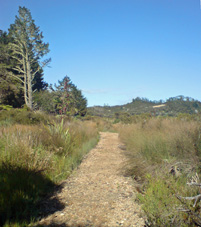
History
On the northern side of Te Wahapu is Pomare Bay, named after one of the chiefs in
whose territory it once was. Ownership ended with the Girls’ War and the settlement
of utu at its conclusion, when Pomare left these parts and went up harbour to
Otuihu (near Opua). In all the little bays there were settlers’ small homes.
You will be walking along the ‘Queen’s Chain’ beside the water. The term originated
from Queen Victoria’s instructions to Governor Hobson in 1840.
The "chain" was the surveyor’s measure, metal links of 7.93 imperial inches, with
100 links making a full chain = 22 yards or 20m. Early surveyors adopted various
practices but the earliest law reserving the land adjacent to water was the Land Act
1892 for sales of Crown land. Many earlier sales failed to set aside the Queen’s Chain
so the popular assumption the Queen’s Chain is a universal right is mistaken.
Pea-stick Bay is a long shallow bay west of the track and mangroves in Pomare Bay.
Local children enjoyed its inexhaustible supply of pipi. The less interesting
"pea-sticks" were probably gathered to stake pea plants each spring.
Orongo Bay means ‘round bay’. Out in the bay there is a natural hot soda spring
bubbling from the seabed beyond the mangrove line. The Orongo Bay Homestead dates
from 1860 - built for Irish born, naturalised American Commercial Agent James G White.
In 1872 the house became the base of the Tikitikioure mining village, then larger
than the nation's capital itself. When the manganese ore and whaling boom died,
the building was a sanatorium for American sailors, a school, and then a Methodist
Church. Ironically, it was later briefly a hotel, before falling, like many of its p
atrons, into disrepair.
The mangrove growth in Orongo Bay is relatively recent and reportedly dates from
siltation caused by spoil from cuttings during development of Aucks Road.
Hirst Reserve is named after local landowner, Len Hirst, who farmed livestock and
oysters. The reserve was given when he subdivided his property and is maintained
by the Department of Conservation.
|